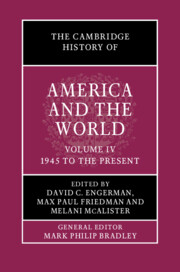Book contents
- The Cambridge History of America and the World
- The Cambridge History of America and the World
- The Cambridge History of America and the World
- Copyright page
- Contents
- Figures
- Maps
- Contributors to Volume IV
- General Introduction: What is America and the World?
- Introduction to Volume IV
- Part I Ordering a World of States
- Part II Challenging a World of States
- 10 US Foreign Policy and the End of Development
- 11 Oil and American Insecurity
- 12 US Mass Culture and Consumption in a Global Context
- 13 Imperial Visions of the World
- 14 Human Rights
- 15 Compassion and Humanitarianism in International Relations
- 16 Third World Internationalism and the Global Color Line
- 17 The Queering of US Geopolitics
- 18 Migration, War, and the Transformation of the US Population
- 19 Christian and Muslim Transnational Networks
- 20 Native Americans, Indigeneity, and US Foreign Policy
- 21 Environment, Climate, and Global Disorder
- 22 Détente and the Reconfiguration of Superpower Relations
- Part III New World Disorder?
- Index
18 - Migration, War, and the Transformation of the US Population
from Part II - Challenging a World of States
Published online by Cambridge University Press: 12 November 2021
- The Cambridge History of America and the World
- The Cambridge History of America and the World
- The Cambridge History of America and the World
- Copyright page
- Contents
- Figures
- Maps
- Contributors to Volume IV
- General Introduction: What is America and the World?
- Introduction to Volume IV
- Part I Ordering a World of States
- Part II Challenging a World of States
- 10 US Foreign Policy and the End of Development
- 11 Oil and American Insecurity
- 12 US Mass Culture and Consumption in a Global Context
- 13 Imperial Visions of the World
- 14 Human Rights
- 15 Compassion and Humanitarianism in International Relations
- 16 Third World Internationalism and the Global Color Line
- 17 The Queering of US Geopolitics
- 18 Migration, War, and the Transformation of the US Population
- 19 Christian and Muslim Transnational Networks
- 20 Native Americans, Indigeneity, and US Foreign Policy
- 21 Environment, Climate, and Global Disorder
- 22 Détente and the Reconfiguration of Superpower Relations
- Part III New World Disorder?
- Index
Summary
Migration scholars frame the history of immigration to the United States in terms of “pre-1965” and “post-1965” to emphasize the major demographic changes that US society experienced after the passage of the Immigration and Naturalization Act of 1965, also known as the Hart–Celler Act. After decades of rabid nativism, US society, the story goes, became the most diverse in its history after Congress repealed the draconian 1924 Immigration Act in 1965. The 1924 law imposed a near total ban on immigration from Asia and introduced the national origins quota system to curtail immigration from eastern and southern Europe. Scholars portray the years from 1924 to 1965 as a period characterized by a lull in immigration, isolationism, and xenophobia. Yet, the period was much more dynamic than it first appears and, especially after the late 1930s, ushered in many of the changes that led to the demographic shifts usually attributed to the passage of the 1965 Immigration and Nationality Act.
- Type
- Chapter
- Information
- The Cambridge History of America and the World , pp. 419 - 439Publisher: Cambridge University PressPrint publication year: 2022

